 | –≠–ª–µ–∫—Ç—Ä–æ–Ω–Ω—ã–π –∫–æ–º–ø–æ–Ω–µ–Ω—Ç: 83C196EA | –°–∫–∞—á–∞—Ç—å:  PDF PDF  ZIP ZIP |

ADVANCE INFORMATION
COPYRIGHT © INTEL CORPORATION, 1997
March 1997
Order Number: 272788-002
83C196EA
CHMOS 16-BIT MICROCONTROLLER
Automotive
The 83C196EA is the first member of a new family of microcontrollers with features that are useful in
automotive applications, such as powertrain control. Two Mbytes of linear address space provide more space
for high-level language compilation. A demultiplexed address/data bus and three chip-select signals make it
easier to design low-cost memory solutions. The external bus can dynamically switch between multiplexed
and demultiplexed operation.
NOTE
This datasheet contains information on products being sampled or in the initial production
phase of development. The specifications are subject to change without notice. Verify
with your local Intel sales office that you have the latest datasheet before finalizing a
design.
s
40 MHz operation
s
Optional clock doubler
s
2 Mbytes of linear address space
s
1 Kbyte of register RAM
s
3 Kbytes of code RAM
s
8 Kbytes of ROM
s
Register-to-register architecture
s
Stack overflow/underflow monitor with
user-defined upper and lower stack
pointer boundary limits
s
2 peripheral interrupt handlers (PIH)
provide direct hardware handling of up
to 16 peripheral interrupts
s
Peripheral transaction server (PTS) with
high-speed, microcoded interrupt
service routines
s
Up to 83 I/O port pins
s
2 full-duplex serial ports with dedicated
baud-rate generators
s
Enhanced synchronous serial unit
s
8 pulse-width modulator (PWM) outputs
with 8-bit resolution
s
16-bit watchdog timer
s
Sixteen 10-bit A/D channels with auto-
scan mode and dedicated results
registers
s
Serial debug unit provides read and
write access to code RAM with no CPU
overhead
s
Chip-select unit (CSU)
s
3 chip-select pins
s
Dynamic demultiplexed/multiplexed
address/data bus for each
chip-select
s
Programmable wait states
(0, 1, 2, or 3) for each chip-select
s
Programmable bus width
(8- or 16-bit) for each chip-select
s
Programmable address range for each
chip-select
s
Event processor array (EPA)
s
4 flexible 16-bit timer/counters
s
17 high-speed capture/compare
channels
s
8 output-only channels capture value of
any other timer upon compare, providing
easy conversion between angle and time
domains
s
Programmable clock output signal
s
160-pin QFP package
s
Complete system development support
s
High-speed CHMOS technology

Information in this document is provided in connection with Intel products. No license, express or implied, by
estoppel or otherwise, to any intellectual property rights is granted by this document. Except as provided in
Intel's Terms and Conditions of Sale for such products, Intel assumes no liability whatsoever, and Intel dis-
claims any express or implied warranty, relating to sale and/or use of Intel products including liability or war-
ranties relating to fitness for a particular purpose, merchantability, or infringement of any patent, copyright or
other intellectual property right. Intel products are not intended for use in medical, life saving, or life sustaining
applications.
Intel retains the right to make changes to specifications and product descriptions at any time, without notice.
*Third-party brands and names are the property of their respective owners.
Copies of documents which have an ordering number and are referenced in this document, or other Intel liter-
ature, may be obtained from:
Intel Corporation
P.O. Box 7641
Mt. Prospect, IL 60056-7641
or call 1-800-548-4725

ADVANCE INFORMATION
iii
CONTENTS
83C196EA
CHMOS 16-bit Microcontroller
1.0
Product Overview ................................................................................................................ 1
2.0
Nomenclature Overview ...................................................................................................... 2
3.0
Pinout .................................................................................................................................. 3
4.0
Signals ................................................................................................................................ 6
5.0
Address Map ..................................................................................................................... 15
6.0
Electrical Characteristics ................................................................................................... 17
6.1
DC Characteristics........................................................................................................ 17
6.2
AC Characteristics -- Multiplexed Bus Mode............................................................... 19
6.3
AC Characteristics -- Demultiplexed Bus Mode .......................................................... 23
6.4
Deferred Bus Timing Mode........................................................................................... 27
6.5
AC Characteristics -- Serial Port, Shift Register Mode................................................ 28
6.6
AC Characteristics -- Synchronous Serial Port ........................................................... 29
6.7
A/D Sample and Conversion Times ............................................................................. 30
6.7.1
AC Characteristics -- A/D Converter, 10-bit Mode ............................................... 31
6.7.2
AC Characteristics -- A/D Converter, 8-bit Mode ................................................. 32
6.8
External Clock Drive ..................................................................................................... 34
6.9
Test Output Waveforms ............................................................................................... 35
7.0
Thermal Characteristics .................................................................................................... 36
8.0
83C196EA Errata .............................................................................................................. 36
9.0
DataSheet Revision History .............................................................................................. 36
Figures
1.
83C196EA Block Diagram....................................................................................................1
2.
Product Nomenclature .........................................................................................................2
3.
83C196EA 160-pin QFP Package .......................................................................................3
4.
System Bus Timing Diagram (Multiplexed Bus Mode) ....................................................... 21
5.
READY Timing Diagram (Multiplexed Bus Mode).............................................................. 22
6.
System Bus Timing Diagram (Demultiplexed Bus Mode) .................................................. 25
7.
READY Timing Diagram (Demultiplexed Bus Mode) ......................................................... 26
8.
Deferred Bus Mode Timing Diagram.................................................................................. 27
9.
Serial Port Waveform -- Shift Register Mode .................................................................... 28
10.
Synchronous Serial Port .................................................................................................... 29
11.
External Clock Drive Waveforms........................................................................................ 34
12.
AC Testing Output Waveforms........................................................................................... 35
13.
Float Waveforms During 5.0 Volt Testing........................................................................... 35

iv
ADVANCE INFORMATION
CONTENTS
Tables
1.
Description of Product Nomenclature .................................................................................. 2
2.
83C196EA 160-pin QFP Package Pin Assignments............................................................ 4
3.
Pin Assignment Arranged by Functional Categories............................................................ 5
4.
Signal Descriptions .............................................................................................................. 6
5.
83C196EA Address Map.................................................................................................... 15
6.
DC Characteristics at V
CC
= 4.5 V ≠ 5.5 V.......................................................................... 17
7.
AC Characteristics, Multiplexed Bus Mode ........................................................................ 19
8.
AC Timing Symbol Definitions............................................................................................ 20
9.
AC Characteristics, Demultiplexed Bus Mode ................................................................... 23
10.
Serial Port Timing -- Shift Register Mode ......................................................................... 28
11.
Synchronous Serial Port Timing......................................................................................... 29
12.
10-bit A/D Operating Conditions (1) ................................................................................... 31
13.
10-bit Mode A/D Characteristics Over Specified Operating Conditions (7)........................ 31
14.
8-bit A/D Operating Conditions (1) ..................................................................................... 32
15.
8-bit Mode A/D Characteristics Over Specified Operating Conditions (7).......................... 33
16.
External Clock Drive........................................................................................................... 34

ADVANCE INFORMATION
1
83C196EA CHMOS 16-BIT MICROCONTROLLER -- AUTOMOTIVE
1.0
PRODUCT OVERVIEW
Figure 1. 83C196EA Block Diagram
The 83C196EA is highly integrated with an enhanced peripheral set. The serial debug unit (SDU) provides
system debug and development capabilities. The SDU can set a single hardware breakpoint and provides
read and write access to code RAM through a high-speed, dedicated serial link. A stack overflow/underflow
monitor assists in code development by causing an unmaskable interrupt if the stack pointer crosses a user-
defined boundary. The 16-channel A/D converter supports an auto-scan mode that operates with no CPU
Code/Data
RAM
3 Kbytes
EPORT
Queue
A20:16
Source (16)
Destination (16)
AD15:0
SIO0
Baud-rate
Generator
EPA
4 Timers
Ports 7,8
Port 11
17 Capture/
Compares
A/D
Converter
Bus
Controller
A15:0
Serial Debug
Unit
Watchdog
Timer
Stack
Overflow
Module
Pulse-width
Modulators
SSIO0
SSIO1
ROM
8 Kbytes
A3178-03
SIO1
Baud-rate
Generator
Port 10
Bus-Control
Interface Unit
Microcode
Engine
Chip-select
Unit
Peripheral
Transaction
Server
Memory
Interface
Unit
Register
RAM
1 Kbyte
ALU
Interrupt
Controller
Peripheral
Interrupt
Handler
Bus Control
Peripheral Addr Bus (10)
Peripheral Data Bus (16)
Memory Addr Bus (24)
Port 12
8 Output/
Simulcaptures
Port 9
Port 2
Memory Data Bus (16)

2
ADVANCE INFORMATION
83C196EA CHMOS 16-BIT MICROCONTROLLER -- AUTOMOTIVE
overhead. Each A/D channel has a dedicated result register. The EPA supports high-speed input captures
and output compares with 17 programmable, high-speed capture/compare channels. Eight output-only
channels provide support for time-base conversions by capturing the value of one of four timers when a
compare occurs.
2.0
NOMENCLATURE OVERVIEW
Figure 2. Product Nomenclature
Table 1. Description of Product Nomenclature
Parameter
Options
Description
Temperature and Burn-in Options
A
Automotive operating temperature range (≠40∞ C to
125∞ C case) with Intel standard burn-in.
Packaging Options
S
QFP
Program Memory Options
3
Internal ROM
Process Information
C
CHMOS
Product Family
196EA
Device Speed
no mark
40 MHz
Program Memory Options
XXXXX
XX
X
X
8
XX
X
Packaging Options
Temperature and Burn-in Options
A2815-01
Process Information
Product Family Device Speed

ADVANCE INFORMATION
3
83C196EA CHMOS 16-BIT MICROCONTROLLER -- AUTOMOTIVE
3.0
PINOUT
Figure 3. 83C196EA 160-pin QFP Package
A3151-02
120
119
118
117
116
115
114
113
112
111
110
109
108
107
106
105
104
103
102
101
100
99
98
97
96
95
94
93
92
91
90
89
88
87
86
85
84
83
82
81
AS83C196EA
View of component as
mounted on PC board
1
2
3
4
5
6
7
8
9
10
11
12
13
14
15
16
17
18
19
20
21
22
23
24
25
26
27
28
29
30
31
32
33
34
35
36
37
38
39
40
41
42
43
44
45
46
47
48
49
50
51
52
53
54
55
56
57
58
59
60
61
62
63
64
65
66
67
68
69
70
71
72
73
74
75
76
77
78
79
80
160
159
158
157
156
155
154
153
152
151
150
149
148
147
146
145
144
143
142
141
140
139
138
137
136
135
134
133
132
131
130
129
128
127
126
125
124
123
122
121
AD0 / P3.0
AD1 / P3.1
AD2 / P3.2
AD3 / P3.3
AD4 / P3.4
AD5 / P3.5
AD6 / P3.6
AD7 / P3.7
V
CC
V
CC
V
SS
V
SS
AD8 / P4.0
AD9 / P4.1
AD10 / P4.2
AD11 / P4.3
AD12 / P4.4
AD13 / P4.5
AD14 / P4.6
AD15 / P4.7
P5.7 / RPD
P5.4/BREQ#/TMODE#
P5.6 / READY
P5.1 / INST
P5.0 / ALE
P5.5 / BHE# / WRH#
P5.3 / RD#
P5.2 / WR# / WRL#
V
SS
V
CC
A20 / EPORT.4
A16 / EPORT.0
A17 / EPORT.1
A18 / EPORT.2
A19 / EPORT.3
EPORT.5 / CS0#
EPORT.6 / CS1#
EPORT.7 / CS2#
NC
NC
NC
NC
NC
NC
EA#
V
CC
PLLEN
XTAL2
XTAL1
V
SS
V
CC
P2.7 / CLKOUT
P2.6 / ONCE#
P2.5
P2.4 /RXD1
P2.3 / TXD1
P2.2 / EXTINT
P2.1 / RXD0
P2.0 / TXD0
V
CC
V
SS
CRBUSY#
CROUT
CRIN
CRDCLK
V
CC
NC
V
SS
V
SS
ACH15
ACH14
ACH13
ACH12
ACH11
ACH10
ACH9
ACH8
ACH7
ACH6
NC
A15
A14
A13
A12
A11
A10
A9
A8
V
CC
V
SS
A7
A6
A5
A4
A3
A2
A1
A0
P9.7 / OS7
P9.6 / OS6
P9.5 / OS5
P9.4 / OS4
P9.3 / OS3
P9.2 / OS2
P9.1 / OS1
P9.0 / OS0
P7.0 / EPA0 / T1CLK
P7.1 / EPA1 / T1RST
P7.2 / EPA2 / T2CLK
P7.3 / EPA3 / T2RST
P7.4 / EPA4 / T3CLK
P7.5 / EPA5 / T3RST
V
SS
V
CC
P7.6 / EPA6 / T4CLK
P7.7 / EPA7 / T4RST
P8.7 / EPA15
P8.6 / EPA14
P8.5 / EPA13
NC
P8.4 / EPA12
P8.3 / EPA11
P8.2 / EPA10
P8.1 / EPA9
P8.0 / EPA8
P10.5
P10.4 / EPA16
P10.3 / SD1
P10.2 / SC1 / CHS#
P10.1 / SD0
P10.0 / SC0
P11.4 / PWM4
P11.5 / PWM5
P11.6 / PWM6
P11.7 / PWM7
P11.3 / PWM3
P11.2 / PWM2
P11.1 / PWM1
P11.0 / PWM0
V
SS
V
CC
P12.4
P12.0
P12.1
P12.2
P12.3
V
SS
NC
V
CC
NC
RESET#
NMI
V
REF
ANGND
ACH0
ACH1
ACH2
ACH3
ACH4
ACH5
This pin supplies voltage to the phase-locked loop circuitry, so use extra care to keep it stable.
This pin supplies voltage to the code RAM. Maintain at 5 volts to retain data in code RAM.
NC pins must be unconnected to prevent accidental entry into a test mode.
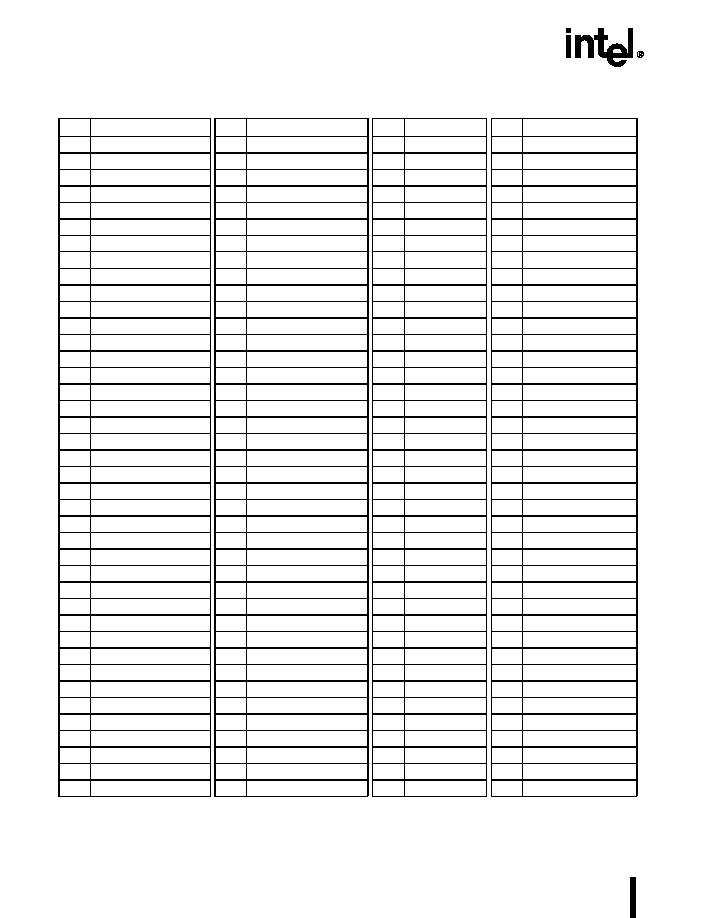
4
ADVANCE INFORMATION
83C196EA CHMOS 16-BIT MICROCONTROLLER -- AUTOMOTIVE
Table 2. 83C196EA 160-pin QFP Package Pin Assignments
Pin
Name
Pin
Name
Pin
Name
Pin
Name
1
AD0 / P3.0
41
NC
81
ACH5
121
NC
2
AD1 / P3.1
42
NC
82
ACH4
122
P8.5 / EPA13
3
AD2 / P3.2
43
NC
83
ACH3
123
P8.6 / EPA14
4
AD3 / P3.3
44
NC
84
ACH2
124
P8.7 / EPA15
5
AD4 / P3.4
45
EA#
85
ACH1
125
P7.7 / EPA7 / T4RST
6
AD5 / P3.5
46
V
CC
86
ACH0
126
P7.6 / EPA6 / T4CLK
7
AD6 / P3.6
47
PLLEN
87
ANGND
127
V
CC
8
AD7 / P3.7
48
XTAL2
88
V
REF
128
V
SS
9
V
CC
49
XTAL1
89
NMI
129
P7.5 / EPA5 / T3RST
10
V
CC
50
V
SS
90
RESET#
130
P7.4 / EPA4 / T3CLK
11
V
SS
51
V
CC
91
NC
131
P7.3 / EPA3 / T2RST
12
V
SS
52
P2.7 / CLKOUT
92
V
CC
132
P7.2 / EPA2 / T2CLK
13
AD8 / P4.0
53
P2.6 / ONCE#
93
NC
133
P7.1 / EPA1 / T1RST
14
AD9 / P4.1
54
P2.5
94
V
SS
134
P7.0 / EPA0 / T1CLK
15
AD10 / P4.2
55
P2.4 / RXD1
95
P12.3
135
P9.0 / OS0
16
AD11 / P4.3
56
P2.3 / TXD1
96
P12.2
136
P9.1 / OS1
17
AD12 / P4.4
57
P2.2 / EXTINT
97
P12.1
137
P9.2 / OS2
18
AD13 / P4.5
58
P2.1 / RXD0
98
P12.0
138
P9.3 / OS3
19
AD14 / P4.6
59
P2.0 / TXD0
99
P12.4
139
P9.4 / OS4
20
AD15 / P4.7
60
V
CC
100
V
CC
140
P9.5 / OS5
21
P5.7 / RPD
61
V
SS
101
V
SS
141
P9.6 / OS6
22
P5.4/BREQ#/TMODE#
62
CRBUSY#
102
P11.0 / PWM0
142
P9.7 / OS7
23
P5.6 / READY
63
CROUT
103
P11.1 / PWM1
143
A0
24
P5.1 / INST
64
CRIN
104
P11.2 / PWM2
144
A1
25
P5.0 / ALE
65
CRDCLK
105
P11.3 / PWM3
145
A2
26
P5.5 / BHE# / WRH#
66
V
CC
106
P11.7 / PWM7
146
A3
27
P5.3 / RD#
67
NC
107
P11.6 / PWM6
147
A4
28
P5.2 / WR# / WRL#
68
V
SS
108
P11.5 / PWM5
148
A5
29
V
SS
69
V
SS
109
P11.4 / PWM4
149
A6
30
V
CC
70
ACH15
110
P10.0 / SC0
150
A7
31
A20 / EPORT.4
71
ACH14
111
P10.1 / SD0
151
V
SS
32
A16 / EPORT.0
72
ACH13
112
P10.2 / SC1
152
V
CC
33
A17 / EPORT.1
73
ACH12
113
P10.3 / SD1
153
A8
34
A18 / EPORT.2
74
ACH11
114
P10.4 / EPA16
154
A9
35
A19 / EPORT.3
75
ACH10
115
P10.5
155
A10
36
EPORT.5 / CS0#
76
ACH9
116
P8.0 / EPA8
156
A11
37
EPORT.6 / CS1#
77
ACH8
117
P8.1 / EPA9
157
A12
38
EPORT.7 / CS2#
78
ACH7
118
P8.2 / EPA10
158
A13
39
NC
79
ACH6
119
P8.3 / EPA11
159
A14
40
NC
80
NC
120
P8.4 /EPA12
160
A15
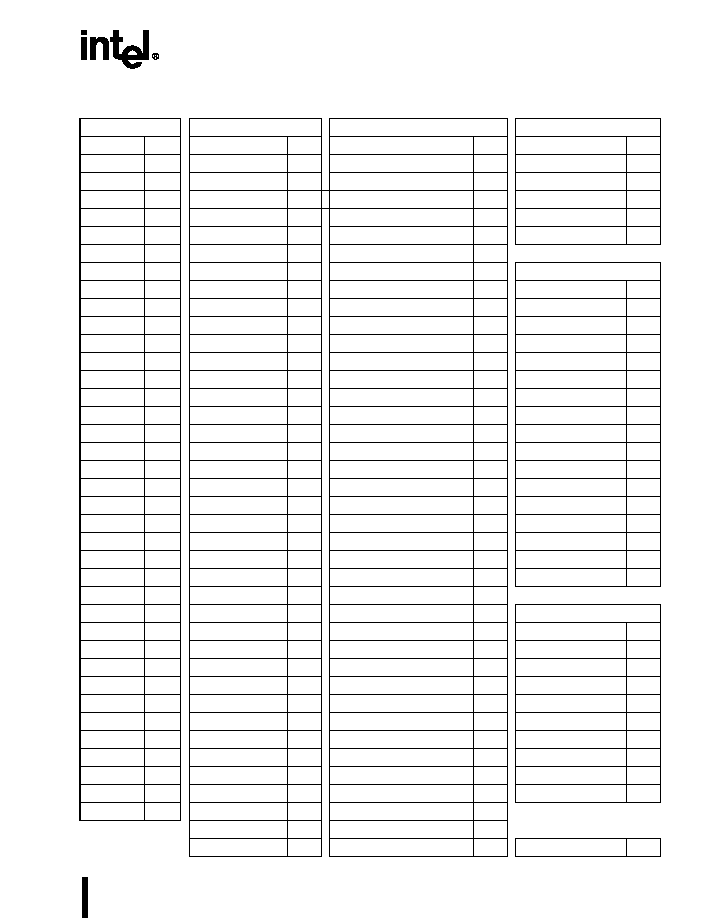
ADVANCE INFORMATION
5
83C196EA CHMOS 16-BIT MICROCONTROLLER -- AUTOMOTIVE
Table 3. Pin Assignment Arranged by Functional Categories
Addr & Data
Input/Output
Input/Output (Cont'd)
Input/Output (Cont'd)
Name
Pin
Name
Pin
Name
Pin
Name
Pin
A0
143
P2.0 / TXD0
59
EPORT.7
38
P12.0
98
A1
144
P2.1 / RXD0
58
P7.0 / EPA0 / T1CLK
134
P12.1
97
A2
145
P2.2 57
P7.1 / EPA1 / T1RST
133
P12.2
96
A3
146
P2.3 / TXD1
56
P7.2 / EPA2 / T2CLK
132
P12.3
95
A4
147
P2.4 / RXD1
55
P7.3 / EPA3 / T2RST
131
P12.4
99
A5
148
P2.5 54
P7.4 / EPA4 / T3CLK
130
A6
149
P2.6
53
P7.5 / EPA5 / T3RST
129
Analog Inputs
A7
150
P2.7
52
P7.6 / EPA6 / T4CLK
126
Name
Pin
A8
153
P3.0
1
P7.7 / EPA7 / T4RST
125
ACH0
86
A9
154
P3.1
2
P8.0 / EPA8
116
ACH1
85
A10
155
R3.2
3
P8.1 / EPA9
117
ACH2
84
A11
156
P3.3
4
P8.2 / EPA10
118
ACH3
83
A12
157
P3.4
5
P8.3 / EPA11
119
ACH4
82
A13
158
P3.5
6
P8.4 / EPA12
120
ACH5
81
A14
159
P3.6
7
P8.5 / EPA13
122
ACH6
79
A15
160
P3.7
8
P8.6 / EPA14
123
ACH7
78
A16
32
P4.0
13
P8.7 / EPA15
124
ACH8
77
A17
33
P4.1
14
P9.0 / OS0
135
ACH9
76
A18
34
P4.2
15
P9.1 / OS1
136
ACH10
75
A19
35
P4.3
16
P9.2 / OS2
137
ACH11
74
A20
31
P4.4
17
P9.3 / OS3
138
ACH12
73
AD0
1
P4.5
18
P9.4 / OS4
139
ACH13
72
AD1
2
P4.6
19
P9.5 / OS5
140
ACH14
71
AD2
3
P4.7
20
P9.6 / OS6
141
ACH15
70
AD3
4
P5.0
25
P9.7 / OS7
142
AD4
5
P5.1
24
P10.0 / SC0
110
Bus Control & Status
AD5
6
P5.2
28
P10.1 / SD0
111
Name
Pin
AD6
7
P5.3
27
P10.2 / SC1
112
ALE
25
AD7
8
P5.4
22
P10.3 / SD1
113
BHE#/WRH#
26
AD8
13
P5.5
26
P10.4 / EPA16
114
BREQ#
22
AD9
14
P5.6
23
P10.5
115
CS0#
36
AD10
15
P5.7
21
P11.0 / PWM0
102
CS1#
37
AD11
16
EPORT.0
32
P11.1 / PWM1
103
CS2#
38
AD12
17
EPORT.1
33
P11.2 / PWM2
104
INST
24
AD13
18
EPORT.2
34
P11.3 / PWM3
105
RD#
27
AD14
19
EPORT.3
35
P11.4 / PWM4
109
READY
23
AD15
20
EPORT.4
31
P11.5 / PWM5
108
EPORT.5
36
P11.6 / PWM6
107
EPORT.6
37
P11.7 / PWM7
106
WR#/WRL#
28

6
ADVANCE INFORMATION
83C196EA CHMOS 16-BIT MICROCONTROLLER -- AUTOMOTIVE
4.0
SIGNALS
Power & Ground
Processor Control
Name
Pins
Name
Pin
ANGND
87
CLKOUT
52
V
CC
9, 10, 30, 46
, 51, 60, 66
, 92, 100, 127, 152
EA#
45
V
SS
11, 12, 29, 50, 61, 68, 69, 94, 101, 128, 151
EXTINT
57
V
REF
88
NMI
89
ONCE#
53
No Connection
PLLEN
47
Name
Pins
RESET#
90
NC
39≠44, 67, 69, 80, 91, 93, 121
RPD
21
TMODE#
22
XTAL1
49
XTAL2
48
This pin supplies voltage to the phase-locked loop circuitry, so use extra
care to keep it stable.
This pin supplies voltage to code RAM. To retain data, maintain 5 volts.
Always leave NC (no connect) pins unconnected to prevent accidental
entry into test modes.
Code Debug
Name
Pin
CRBUSY#
62
CRDCLK
65
CRIN
64
CROUT
63
Table 4. Signal Descriptions
Name
Type
Description
A15:0
I/O
System Address Bus
These address lines provide address bits 0≠15 during the entire external
memory cycle during both multiplexed and demultiplexed bus modes.
A20:16
I/O
Address Lines 16≠20
These address lines provide address bits 16≠20 during the entire external
memory cycle, supporting extended addressing of the 2 Mbyte address space.
NOTE:
Internally, there are 24 address bits; however, only 21 external
address pins (A20:0) are implemented. The internal address space is
16 Mbytes (000000≠FFFFFFH) and the external address space is 2
Mbytes (00000≠1FFFFFH). The device resets to FF2080H in internal
memory or 1F2080H in external memory.
A20:16 are multiplexed with EPORT.4:0.
ACH15:0 I
Analog
Channels
These pins are analog inputs to the A/D converter.
The ANGND and V
REF
pins must be connected for the A/D converter to function.
Table 3. Pin Assignment Arranged by Functional Categories (Continued)

ADVANCE INFORMATION
7
83C196EA CHMOS 16-BIT MICROCONTROLLER -- AUTOMOTIVE
AD15:0
I/O
Address/Data Lines
The function of these pins depend on the bus size and mode. When a bus
access is not occurring, these pins revert to their I/O port function.
16-bit Multiplexed Bus Mode:
AD15:0 drive address bits 0≠15 during the first half of the bus cycle and drive or
receive data during the second half of the bus cycle.
8-bit Multiplexed Bus Mode:
AD15:8 drive address bits 8≠15 during the entire bus cycle. AD7:0 drive
address bits 0≠7 during the first half of the bus cycle and drive or receive data
during the second half of the bus cycle.
16-bit Demultiplexed Mode:
AD15:0 drive or receive data during the entire bus cycle.
8-bit Demultiplexed Mode:
AD7:0 drive or receive data during the entire bus cycle. AD15:8 drive the data
that is currently on the high byte of the internal bus.
ALE
O
Address Latch Enable
This active-high output signal is asserted only during external memory cycles.
ALE signals the start of an external bus cycle and indicates that valid address
information is available on the system address/data bus (A20:16 and AD15:0
for a multiplexed bus; A20:0 for a demultiplexed bus).
An external latch can use this signal to demultiplex address bits 0≠15 from the
address/data bus in multiplexed mode.
ALE shares a package pin with P5.0.
ANGND
GND
Analog Ground
ANGND must be connected for A/D converter operation. ANGND and V
SS
should be nominally at the same potential.
BHE#
O
Byte High Enable
During 16-bit bus cycles, this active-low output signal is asserted for word and
high-byte reads and writes to external memory. BHE# indicates that valid data
is being transferred over the upper half of the system data bus. Use BHE#, in
conjunction with AD0, to determine which memory byte is being transferred
over the system bus:
BHE#
AD0
Byte(s) Accessed
0
0
both bytes
0
1
high byte only
1
0
low byte only
BHE# shares a package pin with P5.5 and WRH#.
The chip configuration register 0 (CCR0) determines whether this pin func-
tions as BHE# or WRH#. CCR0.2 = 1 selects BHE#; CCR0.2 = 0 selects
WRH#.
BREQ#
O
Bus Request
This active-low output signal is asserted during a hold cycle when the bus
controller has a pending external memory cycle.
You must enable the bus-hold protocol before using this signal.
BREQ# shares a package pin with P5.4.
Table 4. Signal Descriptions (Continued)
Name
Type
Description

8
ADVANCE INFORMATION
83C196EA CHMOS 16-BIT MICROCONTROLLER -- AUTOMOTIVE
CLKOUT
O
Clock Output
Output of the internal clock generator. The CLKOUT frequency can be
programmed to one of five frequencies: the internal operating frequency (f)
divided by a factor of two, four, eight, or sixteen, or the same frequency as the
oscillator input (F
XTAL
1
). CLKOUT has a 50% duty cycle.
CLKOUT shares a package pin with P2.7
CRBUSY#
O
Code RAM Busy
This signal indicates that the serial debug unit (SDU) is not ready to conduct a
transaction.
CRDCLK
I
Code RAM Clock
Provides the clock signal for the serial debug unit (SDU). The maximum clock
frequency equals the operating frequency (f) divided by two.
CRIN
I
Code RAM Data Input
Serial input for test instructions and data into the serial debug unit (SDU). Data
is transferred in 8-bit bytes with the most-significant bit (MSB) first. Each byte is
sampled on the rising edge of CRDCLK.
CROUT
O
Code RAM Data Output
Serial output for data from the serial debug unit (SDU). Data is transferred in 8-
bit bytes with the most-significant bit (MSB) first. Each byte is valid on the rising
edge of CRDCLK.
CS2:0#
O
Chip-select Lines 0≠2
The active-low output CS
x
# is asserted during an external memory cycle when
the address to be accessed is in the range programmed for chip select
x
. If the
external memory address is outside the range assigned to the three chip
selects, no chip-select output is asserted and the bus configuration defaults to
the CS2# values.
Immediately following reset, CS0# is automatically assigned to the range
FF2000≠FF20FFH (1F2000≠1F20FFH if external).
CS2:0# share package pins with EPORT.7:5.
EA#
I
External Access
This input determines whether memory accesses to special-purpose and
program memory partitions (FF2000≠FF3FFFH) are directed to internal or
external memory. These accesses are directed to internal memory if EA# is
held high and to external memory if EA# is held low. For an access to any other
memory location, the value of EA# is irrelevant.
EA# is sampled and latched only on the rising edge of RESET#. Changing the
level of EA# after reset has no effect.
On devices with no internal nonvolatile memory, always connect EA# to V
SS
.
EPA16:0
I/O
Event Processor Array (EPA) Capture/Compare Channels
High-speed input/output signals for the EPA capture/compare channels.
EPA16:0 share package pins with the following signals: EPA0/P7.0/T1CLK,
EPA1/P7.1/T1RST, EPA2/P7.2/T2CLK, EPA3/P7.3/T2RST,
EPA4/P7.4/T3CLK, EPA5/P7.5/T3RST, EPA6/P7.6/T4CLK,
EPA7/P7.7/T4RST, EPA8/P8.0, EPA9/P8.1, EPA10/P8.2, EPA11/P8.3,
EPA12/P8.4, EPA13/P8.5, EPA14/P8.6, EPA15/P8.7, and EPA16/P10.4.
Table 4. Signal Descriptions (Continued)
Name
Type
Description

ADVANCE INFORMATION
9
83C196EA CHMOS 16-BIT MICROCONTROLLER -- AUTOMOTIVE
EPORT.7:0
I/O
Extended Addressing Port
This is a standard 8-bit, bidirectional port.
EPORT.4:0 share package pins with A20:16. EPORT7:5 share package pins
with CS2:0#.
EXTINT
I
External Interrupt
In normal operating mode, a rising edge on EXTINT sets the EXTINT interrupt
pending bit. EXTINT is sampled during phase 2 (CLKOUT high). The minimum
high time is one state time.
In powerdown mode, asserting the EXTINT signal for at least 50 ns causes the
device to resume normal operation. The interrupt need not be enabled, but the
pin must be configured as a special-function input. If the EXTINT interrupt is
enabled, the CPU executes the interrupt service routine. Otherwise, the CPU
executes the instruction that immediately follows the command that invoked the
power-saving mode.
In idle mode, asserting any enabled interrupt causes the device to resume
normal operation.
EXTINT shares a package pin with P2.2.
INST
O
Instruction Fetch
This active-high output signal is valid only during external memory bus cycles.
When high, INST indicates that an instruction is being fetched from external
memory. The signal remains high during the entire bus cycle of an external
instruction fetch. INST is low for data accesses, including interrupt vector
fetches and chip configuration byte reads. INST is low during internal memory
fetches.
INST shares a package pin with P5.1.
NMI
I
Nonmaskable Interrupt
In normal operating mode, a rising edge on NMI generates a nonmaskable
interrupt. NMI has the highest priority of all prioritized interrupts. Assert NMI for
greater than one state time to guarantee that it is recognized.
ONCE#
I
On-circuit Emulation
Holding ONCE# low during the rising edge of RESET# places the device into
on-circuit emulation (ONCE) mode. This mode puts all pins into a high-
impedance state, thereby isolating the device from other components in the
system. The value of ONCE# is latched when the RESET# pin goes inactive.
While the device is in ONCE mode, you can debug the system using a clip-on
emulator.
To exit ONCE mode, reset the device by pulling the RESET# signal low. To
prevent inadvertent entry into ONCE mode, either configure this pin as an
output or hold it high during reset and ensure that your system meets the V
IH
specification.
ONCE# shares a package pin with P2.6.
OS7:0
O
Event Processor Array (EPA) Compare-only Channels with Simulcapture
Outputs of the EPA's compare-only channels. These pins are multiplexed with
port 9 and may be configured as standard I/O.
OS7:0 share package pins with P9.7:0.
Table 4. Signal Descriptions (Continued)
Name
Type
Description

10
ADVANCE INFORMATION
83C196EA CHMOS 16-BIT MICROCONTROLLER -- AUTOMOTIVE
P2.7:0
I/O
Port 2
This is a standard, 8-bit, bidirectional port that is multiplexed with individually
selectable special-function signals. P2.6 is multiplexed with ONCE#. To prevent
inadvertent entry into ONCE mode, either configure this pin as an output or hold
it high during reset and ensure that your system meets the V
IH
specification.
Port 2 shares package pins with the following signals: P2.0/TXD0, P2.1/RXD0,
P2.2/EXTINT, P2.3/TXD1, P2.4/RXD1, P2.6/ONCE#, and P2.7/CLKOUT.
P3.7:0
I/O
Port 3
This is a memory-mapped, 8-bit, bidirectional port with programmable open-
drain or complementary output modes. The pins are shared with the
multiplexed address/data bus, which has complementary drivers.
P3.7:0 share package pins with AD7:0.
P4.7:0
I/O
Port 4
This is a memory-mapped, 8-bit, bidirectional port with programmable open-
drain or complementary output modes. The pins are shared with the
multiplexed address/data bus, which has complementary drivers.
P4.7:0 share package pins with AD15:8.
P5.7:0
I/O
Port 5
This is a memory-mapped, 8-bit, bidirectional port that is multiplexed with
individually selectable control signals. P5.4 is multiplexed with TMODE#. If this
pin is held low during reset, the device will enter a test mode. To prevent
inadvertent entry into a reserved test mode, either configure this pin as an
output or hold it high during reset and ensure that your system meets the V
IH
specification.
Port 5 shares package pins with the following signals: P5.0/ALE, P5.1/INST,
P5.2/WR#/WRL#, P5.3/RD#, P5.4/BREQ#/TMODE#, P5.5/BHE#/WRH#,
P5.6/READY, and P5.7/RPD.
P7.7:0
I/O
Port 7
This is a standard, 8-bit, bidirectional port that is multiplexed with individually
selectable special-function signals.
Port 7 shares package pins with the following signals: P7.0/EPA0/T1CLK,
P7.1/EPA1/T1RST, P7.2/EPA2/T2CLK, P7.3/EPA3/T2RST,
P7.4/EPA4/T3CLK, P7.5/EPA5/T3RST, P7.6/EPA6/T4CLK, and
P7.7/EPA7/T4RST.
P8.7:0
I/O
Port 8
This is a standard, 8-bit, bidirectional port that is multiplexed with individually
selectable special-function signals.
P8.7:0 share package pins with EPA15:8.
P9.7:0
I/O
Port 9
This is a standard, 8-bit, bidirectional port that is multiplexed with individually
selectable special-function signals.
P9.7:0 share package pins with OS7:0.
Table 4. Signal Descriptions (Continued)
Name
Type
Description

ADVANCE INFORMATION
11
83C196EA CHMOS 16-BIT MICROCONTROLLER -- AUTOMOTIVE
P10.5:0
I/O
Port 10
This is a standard, 6-bit, bidirectional port that is multiplexed with individually
selectable special-function signals.
Port 10 shares package pins with the following signals: P10.0/SC0, P10.1/SD0,
P10.2/SC1, P10.3/SD1, P10.4/EPA16, and P10.5.
P11.7:0
I/O
Port 11
This is a standard, 8-bit, bidirectional port that is multiplexed with individually
selectable special-function signals.
P11.7:0 share package pins with PWM7:0.
P12.4:0
I/O
Port 12
This is a memory-mapped, 5-bit, bidirectional port. P12.2:0 select the test-ROM
execution mode.
PLLEN
I
Phase-locked Loop Enable
This active-high input pin enables the on-chip clock doubler.
PWM7:0
O
Pulse Width Modulator Outputs
These are PWM output pins with high-current drive capability.
PWM7:0 share package pins with P11.7:0.
RD#
O
Read
Read-signal output to external memory. RD# is asserted only during external
memory reads.
RD# shares a package pin with P5.3.
READY
I
Ready Input
This active-high input signal is used to lengthen external memory cycles for
slow memory by generating wait states in addition to the wait states that are
generated internally.
When READY is high, CPU operation continues in a normal manner with wait
states inserted as programmed in the chip configuration registers or the chip-
select
x
bus control register. READY is ignored for all internal memory
accesses.
READY shares a package pin with P5.6.
RESET#
I/O
Reset
A level-sensitive reset input to and open-drain system reset output from the
microcontroller. Either a falling edge on RESET# or an internal reset turns on a
pull-down transistor connected to the RESET# pin for 16 state times. In the
powerdown and idle modes, asserting RESET# causes the chip to reset and
return to normal operating mode. After a device reset, the first instruction fetch
is from FF2080H (or 1F2080H in external memory).
Table 4. Signal Descriptions (Continued)
Name
Type
Description

12
ADVANCE INFORMATION
83C196EA CHMOS 16-BIT MICROCONTROLLER -- AUTOMOTIVE
RPD
I
Return from Powerdown
Timing pin for the return-from-powerdown circuit.
If your application uses powerdown mode, connect a capacitor between RPD
and V
SS
if either of the following conditions are true.
∑ the internal oscillator is the clock source
∑ the phase-locked loop (PLL) circuitry is enabled (see PLLEN signal
description)
The capacitor causes a delay that enables the oscillator and PLL circuitry to
stabilize before the internal CPU and peripheral clocks are enabled.
The capacitor is not required if your application uses powerdown mode and if
both of the following conditions are true.
∑ an external clock input is the clock source
∑ the phase-locked loop circuitry is disabled
If your application does not use powerdown mode, leave this pin unconnected.
RPD shares a package pin with P5.7.
RXD1:0
I/O
Receive Serial Data 0 and 1
In modes 1, 2, and 3, RXD0 and 1 receive serial port input data. In mode 0, they
functions as either inputs or open-drain outputs for data.
RXD0 shares a package pin with P2.1 and RXD1 shares a package pin with
P2.4.
SC1:0
I/O
Clock Pins for SSIO0 and 1
For handshaking mode, configure SC1:0 as open-drain outputs.
This pin carries a signal only during receptions and transmissions. When the
SSIO port is idle, the pin remains either high (with handshaking) or low (without
handshaking).
SC0 shares a package pin with P10.0, and SC1 shares a package pin with
P10.2.
SD1:0
I/O
Data Pins for SSIO0 and 1
These pins are the data I/O pins for SSIO0 and 1.
SD0 shares a package pin with P10.1, and SD1 shares a package pin with
P10.1.
T1CLK
I
Timer 1 External Clock
External clock for timer 1.Timer 1 is programmable to increment or decement
on the rising edge, the falling edge, or both rising and falling edges of T1CLK.
and
External clock for the serial I/O baud-rate generator input (program selectable).
T1CLK shares a package pin with P7.0 and EPA0.
T2CLK
I
Timer 2 External Clock
External clock for timer 2. Timer 2 is programmable to increment or decement
on the rising edge, the falling edge, or both rising and falling edges of T2CLK.
T2CLK shares a package pin with P7.2 and EPA2.
Table 4. Signal Descriptions (Continued)
Name
Type
Description

ADVANCE INFORMATION
13
83C196EA CHMOS 16-BIT MICROCONTROLLER -- AUTOMOTIVE
T3CLK
I
Timer 3 External Clock
External clock for timer 3. Timer 3 is programmable to increment or decement
on the rising edge, the falling edge, or both rising and falling edges of T3CLK.
T3CLK shares a package pin with P7.4 and EPA4.
T4CLK
I
Timer 4 External Clock
External clock for timer 4. Timer 2 is programmable to increment or decement
on the rising edge, the falling edge, or both rising and falling edges of T4CLK.
T4CLK shares a package pin with P7.6 and EPA6.
T1RST
I
Timer 1 External Reset
External reset for timer 1. Timer 1 is programmable to reset on the rising edge,
the falling edge, or both rising and falling edges of T1RST.
T1RST shares a package pin with P7.1 and EPA1.
T2RST
I
Timer 2 External Reset
External reset for timer 2. Timer 2 is programmable to reset on the rising edge,
the falling edge, or both rising and falling edges of T2RST.
T2RST shares a package pin with P7.3 and EPA3.
T3RST
I
Timer 3 External Reset
External reset for timer 3. Timer 3 is programmable to reset on the rising edge,
the falling edge, or both rising and falling edges of T3RST.
T3RST shares a package pin with P7.5 and EPA5.
T4RST
I
Timer 4 External Reset
External reset for timer 4. Timer 4 is programmable to reset on the rising edge,
the falling edge, or both rising and falling edges of T4RST.
T4RST shares a package pin with P7.6 and EPA6.
TMODE#
I
Test-Mode Entry
If this pin is held low during reset, the device will enter a test mode. The value of
several other pins defines the actual test mode. All test modes, except test-
ROM execution, are reserved for Intel factory use. If you choose to configure
this signal as an input, always hold it high during reset and ensure that your
system meets the V
IH
specification to prevent inadvertent entry into test mode.
TMODE# shares a package pin with P5.4 and BREQ#.
TXD1:0
O
Transmit Serial Data 0 and 1
In serial I/O modes 1, 2, and 3, TXD0 and 1 transmit serial port output data. In
mode 0, they are the serial clock output.
TXD0 shares a package pin with P2.0 and TXD1 shares a package pin with
P2.3.
V
CC
PWR
Digital Supply Voltage
Connect each V
CC
pin to the digital supply voltage.
V
REF
PWR
Reference Voltage for the A/D Converter
This pin also supplies operating voltage to the analog portion of the A/D
converter.
Table 4. Signal Descriptions (Continued)
Name
Type
Description

14
ADVANCE INFORMATION
83C196EA CHMOS 16-BIT MICROCONTROLLER -- AUTOMOTIVE
V
SS
GND
Digital Circuit Ground
These pins supply ground for the digital circuitry. Connect each V
SS
pin to
ground through the lowest possible impedance path.
WR#
O
Write
This active-low output indicates that an external write is occurring. This signal is
asserted only during external memory writes.
WR# is multiplexed with P5.2 and WRL#.
The chip configuration register 0 (CCR0) determines whether this pin func-
tions as WR# or WRL#. CCR0.2 = 1 selects WR#; CCR0.2 = 0 selects WRL#.
WRH#
O
Write High
During 16-bit bus cycles, this active-low output signal is asserted for high-byte
writes and word writes to external memory. During 8-bit bus cycles, WRH# is
asserted for all write operations.
WRH# shares a package pin with P5.5 and BHE#.
The chip configuration register 0 (CCR0) determines whether this pin func-
tions as BHE# or WRH#. CCR0.2 = 1 selects BHE#; CCR0.2 = 0 selects
WRH#.
WRL#
O
Write Low
During 16-bit bus cycles, this active-low output signal is asserted for low-byte
writes and word writes to external memory. During 8-bit bus cycles, WRL# is
asserted for all write operations.
WRL# shares a package pin with P5.2 and WR#.
The chip configuration register 0 (CCR0) determines whether this pin func-
tions as WR# or WRL#. CCR0.2 = 1 selects WR#; CCR0.2 = 0 selects WRL#.
XTAL1
I
Input Crystal/Resonator or External Clock Input
Input to the on-chip oscillator and the internal clock generators. The internal
clock generators provide the peripheral clocks, CPU clock, and CLKOUT
signal. When using an external clock sourcel instead of the on-chip oscillator,
connect the clock input to XTAL1. The external clock signal must meet the V
IH
specification for XTAL1.
XTAL2
O
Inverted Output for the Crystal/Resonator
Output of the on-chip oscillator inverter. Leave XTAL2 floating when the design
uses an external clock source instead of the on-chip oscillator.
Table 4. Signal Descriptions (Continued)
Name
Type
Description

ADVANCE INFORMATION
15
83C196EA CHMOS 16-BIT MICROCONTROLLER -- AUTOMOTIVE
5.0
ADDRESS MAP
Table 5. 83C196EA Address Map
Hex
Address
Description (Note 1, Note 2)
Addressing
Modes
FFFFFF
FF4000
External device (memory or I/O) connected to address/data bus
Indirect, indexed,
extended
FF3FFF
FF2400
Program memory (Note 3)
Indirect, indexed,
extended
FF23FF
FF2200
Program memory (Note 3)
Indirect, indexed,
extended
FF21FF
FF20C0
Special-purpose memory (PIH vectors; Note 3)
Indirect, indexed,
extended
FF20BF
FF2080
Program memory (Note 3);
(After reset, the first instruction is fetched from FF2080H.)
Indirect, indexed,
extended
FF207F
FF2000
Special-purpose memory (CCBs, interrupt vectors, PTS vectors; Note 3)
Indirect, indexed,
extended
FF1FFF
FF1000
External device (memory or I/O) connected to address/data bus
Indirect, indexed,
extended
FF0FFF
FF0400
Internal code/data RAM (identically mapped from page 00H)
Indirect, indexed,
extended
FF03FF
FF0000
Reserved for in-circuit emulators
--
FEFFFF
1F0000
Overlaid memory (reserved for future devices);
locations
x
F0000≠
x
F03FFH are reserved for in-circuit emulators
Indirect, indexed,
extended
1EFFFF
004000
External device (memory or I/O) connected to address/data bus
Indirect, indexed,
extended
003FFF
002400
A copy of internal ROM (FF2400≠FF3FFFH) if CCB1.2=0
External memory if CCB1.2=1
Indirect, indexed,
extended
0023FF
002000
External device (memory or I/O) connected to address/data bus
Indirect, indexed,
extended
001FFF
001FE0
Memory-mapped special-function registers (SFRs)
Indirect, indexed,
extended
001FDF
001C00
Peripheral special-function registers (SFRs)
Indirect, indexed,
extended,
windowed direct
001BFF
001000
External device (memory or I/O) connected to address/data bus
Indirect, indexed,
extended
000FFF
000400
Internal code/data RAM (identically mapped into page FFH)
Indirect, indexed,
extended
NOTES:
1.
Unless otherwise noted, write 0FFH to reserved memory locations and write 0 to reserved SFR bits.
2.
The contents or functions of reserved locations may change in future device revisions, in which case a
program that relies on one or more of these locations might not function properly.
3.
External memory if EA# is low; internal ROM if EA# is high.

16
ADVANCE INFORMATION
83C196EA CHMOS 16-BIT MICROCONTROLLER -- AUTOMOTIVE
0003FF
000100
Upper register file (general-purpose register RAM)
Indirect, indexed,
windowed direct
0000FF
00001A
Lower register file (general-purpose register RAM)
Direct, indirect,
indexed
000019
000000
Lower register file (stack pointer and CPU SFRs)
Direct, indirect,
indexed
Table 5. 83C196EA Address Map (Continued)
Hex
Address
Description (Note 1, Note 2)
Addressing
Modes
NOTES:
1.
Unless otherwise noted, write 0FFH to reserved memory locations and write 0 to reserved SFR bits.
2.
The contents or functions of reserved locations may change in future device revisions, in which case a
program that relies on one or more of these locations might not function properly.
3.
External memory if EA# is low; internal ROM if EA# is high.

ADVANCE INFORMATION
17
83C196EA CHMOS 16-BIT MICROCONTROLLER -- AUTOMOTIVE
6.0
ELECTRICAL CHARACTERISTICS
6.1
DC Characteristics
ABSOLUTE MAXIMUM RATINGS
Storage Temperature .................................. ≠60∞C to +150∞C
Supply Voltage with Respect to V
SS
............... ≠0.5 V to +7.0 V
Power Dissipation .......................................................... 1.5 W
OPERATING CONDITIONS
T
C
(Case Temperature Under Bias) .............. ≠40∞C to +125∞C
V
CC
(Digital Supply Voltage) .............................. 4.5 V to 5.5 V
V
REF
(Analog Supply Voltage) ........................... 4.5 V to 5.5 V
F
XTAL
1
(Input frequency for V
CC
= 4.5 V ≠ 5.5 V)
(Note 1) ................................................ 20 MHz to 40 MHz
NOTE:
1.
This device is static and should operate below
1 Hz, but has been tested only down to 20 MHz.
NOTICE: This document contains information on
products in the design phase of development. The
specifications are subject to change without notice.
Verify with your local Intel sales office that you
have the latest datasheet before finalizing a
design.
WARNING:
Stressing the device beyond the
"Absolute Maximum Ratings" may cause perma-
nent damage. These are stress ratings only. Oper-
ation beyond the "Operating Conditions" is not
recommended and extended exposure beyond the
"Operating Conditions" may affect device
reliability.
Table 6. DC Characteristics at V
CC
= 4.5 V ≠ 5.5 V
Symbol
Parameter
Min
Typical
(Note 1)
Max
Units
Test
Conditions
I
CC
V
CC
supply current
120
135
mA
XTAL1 = 40 MHz
V
CC
= 5.5 V
Device in Reset
I
IDLE
Idle mode current
60
95
mA
XTAL1 = 40 MHz
V
CC
= 5.5 V
I
PD
Powerdown mode current
20
50
µA
V
CC
= 5.5 V
I
REF
A/D reference supply current
TBD
mA
XTAL1 = 40 MHz
V
CC
= V
REF
= 5.5 V
Device in Reset
I
INJD
Maximum injection current per
port on bidirectional pins
(Note 4)
≠10
10
mA
I
LI
Input leakage current
(Standard inputs except
analog inputs)
≠10
10
µA
V
SS
< V
IN
< V
CC
NOTES:
1.
Typical values are based on a limited number of samples and are not guaranteed. The values listed
are at room temperature with V
CC
= 5.0 V.
2.
For P2.7:0, P3.7:0, P4.7:0, P5.7:0, P6.7:0, P10.3:0, P11.7:0, P12.4:0, AD15:0, EA#, RESET#,
PLLEN, NMI, TDI, TCLK, ONCE#, and XTAL1.
3.
For P7.7:0, P8.7:0, P9.7:0, and P10.5:4.
4.
The maximum injection current is not tested. The device is designed to meet this specification.
5.
Pin capacitance is not tested. This value is based on design simulations.

18
ADVANCE INFORMATION
83C196EA CHMOS 16-BIT MICROCONTROLLER -- AUTOMOTIVE
I
LI
1
Input leakage current
(analog inputs)
≠300
300
nA
V
SS
+ 100 mV <
V
IN
<
V
REF
≠ 100 mV
I
IH
Input high current
(NMI only)
175
µA
NMI = V
CC
= 5.5V
V
IL
1
Input low voltage (Note 2)
≠0.5
0.3 V
CC
V
V
IH
1
Input high voltage (Note 2)
0.7 V
CC
V
CC
+ 0.5
V
V
IL
2
Input low voltage (Note 3)
≠0.5
0.4 V
CC
V
V
IH
2
Input high voltage (Note 3)
0.7 V
CC
V
CC
+ 0.5
V
V
OL
1
Output low voltage (output
configured as complementary)
0.3
0.45
1.5
V
V
V
I
OL
= 200 µA
I
OL
= 3.2 mA
I
OL
= 7.0 mA
V
OH
1
Output high voltage (output
configured as complementary)
V
CC
≠ 0.3
V
CC
≠ 0.7
V
CC
≠ 1.5
V
V
V
I
OH
= ≠200 µA
I
OH
= ≠3.2 mA
I
OH
= ≠7.0 mA
V
OL
2
Output low voltage in reset
0.5
V
I
OL
= 15 µA
I
OH
2
Output high current in reset
≠30
≠75
≠90
≠120
≠240
≠280
mA
mA
mA
V
OH
2
= V
CC
≠ 1.0V
V
OH
2
= V
CC
≠ 2.5V
V
OH
2
= V
CC
≠ 4.0V
I
OH
3
Output high current in reset on
Port 12
TBD
TBD
TBD
≠50
≠110
≠130
mA
mA
mA
V
OH
3
= V
CC
≠ 1.0V
V
OH
3
= V
CC
≠ 2.5V
V
OH
3
= V
CC
≠ 4.0V
V
OH
2
Output high voltage in reset
V
CC
≠ 1
V
I
OH
= ≠15 µA
V
HYS
Hysteresis voltage on all
inputs except XTAL1
700
mV
C
S
Pin Capacitance (any pin to
V
SS
) (Note 5)
10 pF
R
RST
Pull-up resistor on RESET#
pin
9
95
k
V
CC
= 5.5 V,
V
IN
= 4.0 V
Table 6. DC Characteristics at V
CC
= 4.5 V ≠ 5.5 V (Continued)
Symbol
Parameter
Min
Typical
(Note 1)
Max
Units
Test
Conditions
NOTES:
1.
Typical values are based on a limited number of samples and are not guaranteed. The values listed
are at room temperature with V
CC
= 5.0 V.
2.
For P2.7:0, P3.7:0, P4.7:0, P5.7:0, P6.7:0, P10.3:0, P11.7:0, P12.4:0, AD15:0, EA#, RESET#,
PLLEN, NMI, TDI, TCLK, ONCE#, and XTAL1.
3.
For P7.7:0, P8.7:0, P9.7:0, and P10.5:4.
4.
The maximum injection current is not tested. The device is designed to meet this specification.
5.
Pin capacitance is not tested. This value is based on design simulations.
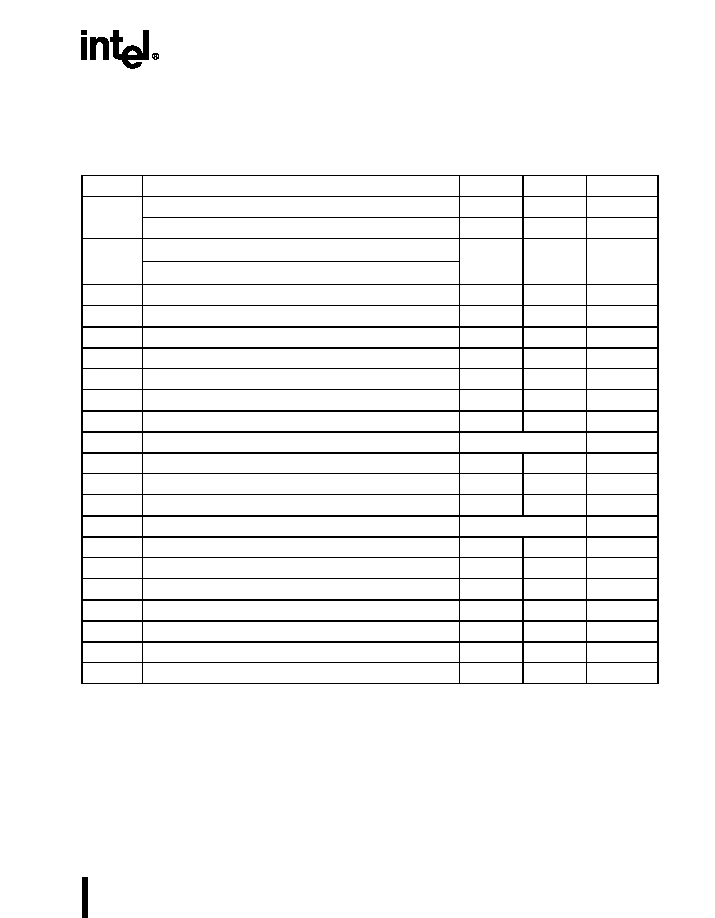
ADVANCE INFORMATION
19
83C196EA CHMOS 16-BIT MICROCONTROLLER -- AUTOMOTIVE
6.2
AC Characteristics -- Multiplexed Bus Mode
Test Conditions: Capacitive load on all pins = 50 pF, Rise and Fall Times = 3 ns.
Table 7. AC Characteristics, Multiplexed Bus Mode
Symbol
Parameter
Min
Max
Units
F
XTAL
1
Frequency on XTAL1, PLL in 1x mode
16
40
MHz (1, 8)
Frequency on XTAL1, PLL in 2x mode
8
20
MHz (8)
f
Operating frequency, f = F
XTAL
1
; PLL in 1x mode
16
40
MHz (8)
Operating frequency, f = 2F
XTAL
1
; PLL in 2x mode
t
Period, t = 1/f
25
62.5
ns
T
AVDV
Address Valid to Input Data Valid
3t ≠ 40
ns (2)
T
RLDV
RD# Low to Input Data Valid
t ≠ 18
ns (2)
T
CHDV
CLKOUT High to Input Data valid
2t ≠ 35
ns (9)
T
RHDZ
RD# High to Input Data Float
t + 5
ns
T
RXDX
Data Hold after RD# Inactive
0
ns
T
XHCH
XTAL1 Rising Edge to CLKOUT High or Low
3
50
ns (9)
T
CLCL
CLKOUT Cycle Time
2t
ns (9)
T
CHCL
CLKOUT High Period
t ≠ 10
t + 10
ns (9)
T
CLLH
CLKOUT Falling to ALE Rising
≠ 10
10
ns (9)
T
LLCH
ALE Falling to CLKOUT Rising
≠ 10
10
ns (9)
T
LHLH
ALE Cycle Time
4t
ns (2)
T
LHLL
ALE High Period
t ≠ 10
t + 10
ns
T
AVLL
Address Setup to ALE Low
t ≠ 15
ns
T
LLAX
Address Hold after ALE Low
t ≠ 15
ns
T
LLRL
ALE Low to RD# Low
t ≠ 15
ns
T
RLCL
RD# Low to CLKOUT Low
≠ 10
10
ns (9)
T
RLRH
RD# Low to RD# High
t ≠ 10
ns (2)
T
RHLH
RD# High to ALE Rising
t ≠ 5
t + 15
ns (3)
NOTES:
1.
16 MHz is the maximum input frequency when using an external crystal oscillator; however, 40MHz
can be applied with an external clock source.
2.
If wait states are used, add 2t
◊
n
, where
n
= number of wait states.
3.
Assuming back-to-back bus cycles.
4.
When forcing wait states using the BUSCON register, add 2t
◊
n.
5.
Exceeding the maximum specification causes additional wait states.
6.
8-bit bus only.
7.
The first falling edge of READY is not synchronized to a CLKOUT edge; therefore, one programmed
wait state is required.
8.
Device is static by design but has been tested only down to 20 MHz.
9.
Assumes CLKOUT is operating in divide-by-two mode (f/2).

20
ADVANCE INFORMATION
83C196EA CHMOS 16-BIT MICROCONTROLLER -- AUTOMOTIVE
T
RLAZ
RD# Low to Address Float
5
ns
T
LLWL
ALE Low to WR# Low
t ≠ 12
ns
T
QVWH
Data Stable to WR# Rising Edge
t ≠ 14
ns (2)
T
CHWH
CLKOUT High to WR# Rising Edge
≠ 10
5
ns (9)
T
WLWH
WR# Low to WR# High
t ≠ 10
ns (2)
T
WHQX
Data Hold after WR# High
t ≠ 15
ns
T
WHLH
WR# High to ALE High
t ≠ 15
t + 10
ns
T
WHBX
BHE#, INST Hold after WR# High
t ≠ 4
ns
T
WHAX
AD15:8, CS
x
# Hold after WR# High
t ≠ 4
ns (6)
T
RHBX
BHE#, INST Hold after RD# High
t ≠ 5
ns
T
RHAX
AD15:8, CS
x
# Hold after RD# High
t ≠ 5
ns (6)
T
W
HSH
A20:0, CS
x
# Hold after WR# High
0
ns
T
RHSH
A20:0, CS
x
# Hold after RD# High
0
ns
T
AVYV
AD15:0 Valid to READY Setup
2t ≠ 40
ns (4)
T
CLYX
READY Hold after CLKOUT Low
0
2t ≠ 40
ns
(5, 7, 9)
T
YLYH
Non-READY Time
No Upper Limit
ns
Table 8. AC Timing Symbol Definitions
Signals
Conditions
A
Address
L
ALE
W
WR#, WRH#, WRL#
H
High
B
BHE#
Q
Output Data
X
XTAL1
L
Low
C
CLKOUT
R
RD#
Y
READY
V
Valid
D
Input Data
S
CS
x
#
X
No Longer Valid
Z
Floating
Address bus (demultiplexed mode) or address/data bus (multiplexed mode)
Table 7. AC Characteristics, Multiplexed Bus Mode (Continued)
Symbol
Parameter
Min
Max
Units
NOTES:
1.
16 MHz is the maximum input frequency when using an external crystal oscillator; however, 40MHz
can be applied with an external clock source.
2.
If wait states are used, add 2t
◊
n
, where
n
= number of wait states.
3.
Assuming back-to-back bus cycles.
4.
When forcing wait states using the BUSCON register, add 2t
◊
n.
5.
Exceeding the maximum specification causes additional wait states.
6.
8-bit bus only.
7.
The first falling edge of READY is not synchronized to a CLKOUT edge; therefore, one programmed
wait state is required.
8.
Device is static by design but has been tested only down to 20 MHz.
9.
Assumes CLKOUT is operating in divide-by-two mode (f/2).

ADVANCE INFORMATION
21
83C196EA CHMOS 16-BIT MICROCONTROLLER -- AUTOMOTIVE
Figure 4. System Bus Timing Diagram (Multiplexed Bus Mode)
CLKOUT
ALE
RD#
A3252-01
AD15:0
(read)
WR#
AD15:0
(write)
BHE#, INST
AD15:8
A20:16
T
LHLH
Address Out
Extended Address Out
t
T
CLLH
T
CLCL
T
CHDV
T
RLCL
T
CHCL
T
LLCH
T
LLRL
T
RHLH
T
RLRH
T
RLDV
T
RHDZ
Data In
T
RLAZ
T
LLAX
Address Out
T
AVDV
T
AVLL
T
CHWH
T
WHLH
T
LLWL
T
WLWH
T
WHQX
Data Out
Address Out
T
WLWH
T
QVWH
T
WHBX
, T
RHBX
High Address Out
T
WHSH
, T
RHSH
CS
x#
T
WHAX
, T
RHAX
T
LHLL
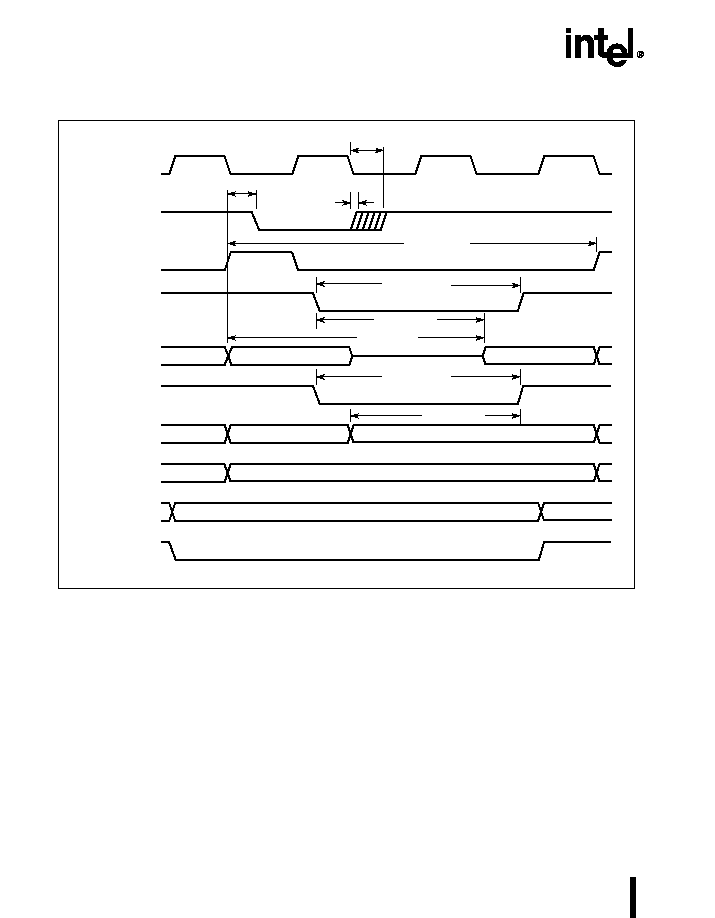
22
ADVANCE INFORMATION
83C196EA CHMOS 16-BIT MICROCONTROLLER -- AUTOMOTIVE
Figure 5. READY Timing Diagram (Multiplexed Bus Mode)
CLKOUT
READY
ALE
A3249-01
T
CLYX
(min)
T
LHLH
+ 2t
T
AVDV
+ 2t
RD#
AD15:0
(read)
AD15:0
(write)
BHE#, INST
A20:16
CS
x
#
T
RLRH
+ 2t
T
AVYV
Data Out
Extended Address Out
Address Out
T
CLYX
(max)
Data In
Address Out
T
RLDV
+ 2t
T
WLWH
+ 2t
T
QVWH
+ 2t
WR#

ADVANCE INFORMATION
23
83C196EA CHMOS 16-BIT MICROCONTROLLER -- AUTOMOTIVE
6.3
AC Characteristics -- Demultiplexed Bus Mode
Test Conditions: Capacitive load on all pins = 50 pF, Rise and Fall Times = 3 ns.
Table 9. AC Characteristics, Demultiplexed Bus Mode
Symbol
Parameter
Min
Max
Units
F
XTAL
1
Frequency on XTAL1, PLL in 1x mode
16
40
MHz (1,8)
Frequency on XTAL1, PLL in 2x mode
8
20
MHz (8)
f
Operating frequency, f = F
XTAL
1
; PLL in 1x mode
16
40
Mhz
Operating frequency, f = 2F
XTAL
1
; PLL in 2x mode
t
Period, t = 1/f
25
62.5
ns
T
AVDV
Address Valid to Input Data Valid
4t ≠ 23
ns (2)
T
RLDV
RD# Low to Input Data Valid
3t ≠ 25
ns (2)
T
AVWL
Address Valid to WR# Low
t
ns
T
AVRL
Address Valid to RD# Low
t ≠ 8
ns
T
SLDV
Chip Select Low to Data Valid
4t ≠ 27
ns (2)
T
CHDV
CLKOUT Rising Edge to Input Data Valid
2t ≠ 25
ns (9)
T
RHDZ
RD# High to Input Data Float
t - 5
ns
T
RHRL
Read High to Next Read Low
t ≠ 5
ns
T
RXDX
Data Hold after RD# Inactive
0
ns
T
XHCH
XTAL1 High to CLKOUT High or Low
10
35
ns (9)
T
CLCL
CLKOUT Cycle Time
2t
ns (9)
T
CHCL
CLKOUT High Period
t ≠ 5
t + 5
ns (9)
T
CLLH
CLKOUT Falling ALE Rising
≠ 5
5
ns (9)
T
RLCL
RD# Low to CLKOUT Low
≠ 5
5
ns (9)
T
RLRH
RD# Low to RD# High
3t ≠ 10
ns (2)
T
RHLH
RD# Rising to ALE Rising
t ≠ 4
t + 12
ns (3)
T
WLCL
WR# Low to CLKOUT Falling
≠ 12
5
ns (9)
T
QVWH
Data Stable to WR# Rising Edge
3t ≠ 18
ns (3)
1.
16 MHz is the maximum input frequency when using an external crystal oscillator; however, 40 MHz
can be applied with an external clock source.
2.
If wait states are used, add 2t
◊
n
, where
n
= number of wait states.
3.
Assuming back-to-back bus cycles.
4.
When forcing wait states using the BUSCON register, add 2t
◊
n.
5.
Exceeding the maximum specification causes additional wait states.
6.
8-bit bus only.
7.
The first falling edge of READY is not synchronized to a CLKOUT edge; therefore, one programmed
wait state is required.
8.
Device is static by design but has been tested only down to 20 MHz.
9.
Assumes CLKOUT is operating in divide-by-two mode (f/2).

24
ADVANCE INFORMATION
83C196EA CHMOS 16-BIT MICROCONTROLLER -- AUTOMOTIVE
T
CHWH
CLKOUT High to WR# Rising Edge
≠ 5
10
ns (9)
T
WLWH
WR# Low to WR# High
3t ≠ 12
ns (2)
T
WHQX
Data Hold after WR# Rising Edge
t
t + 15
ns
T
WHBX
BHE#, INST Hold after WR# High
t
ns
T
WHAX
A20:0, CS
x
# Hold after WR# High
0
ns
T
RHBX
BHE#, INST Hold after RD# High
t
ns
T
RHAX
A20:0, CS
x
# Hold after RD# High
0
ns
T
AVYV
A20:0 Valid to READY Setup
3t ≠ 23
ns (4)
T
CLYX
READY Hold after CLKOUT Low
0
2t ≠ 28
ns
(5, 7,9)
T
YLYH
Non READY Time
No Upper Limit
ns
Table 9. AC Characteristics, Demultiplexed Bus Mode (Continued)
Symbol
Parameter
Min
Max
Units
1.
16 MHz is the maximum input frequency when using an external crystal oscillator; however, 40 MHz
can be applied with an external clock source.
2.
If wait states are used, add 2t
◊
n
, where
n
= number of wait states.
3.
Assuming back-to-back bus cycles.
4.
When forcing wait states using the BUSCON register, add 2t
◊
n.
5.
Exceeding the maximum specification causes additional wait states.
6.
8-bit bus only.
7.
The first falling edge of READY is not synchronized to a CLKOUT edge; therefore, one programmed
wait state is required.
8.
Device is static by design but has been tested only down to 20 MHz.
9.
Assumes CLKOUT is operating in divide-by-two mode (f/2).

ADVANCE INFORMATION
25
83C196EA CHMOS 16-BIT MICROCONTROLLER -- AUTOMOTIVE
Figure 6. System Bus Timing Diagram (Demultiplexed Bus Mode)
CLKOUT
ALE
RD#
A5397-01
AD15:0
(read)
WR#
AD15:0
(write)
BHE#, INST
A20:0
Address Out
T
CHCL
T
CLCL
T
CHWH
T
RHRL
T
RHDZ
Data In
T
RLRH
T
AVDV
T
WHQX
T
WHAX
T
WLCL
Data Out
T
WLWH
T
QVWH
T
WHBX
, T
RHBX
CS
x
#
T
CLLH
t
T
RHLH
T
AVRL
T
RHAX
T
SLDV
T
CHDV
T
RLDV
T
AVWL
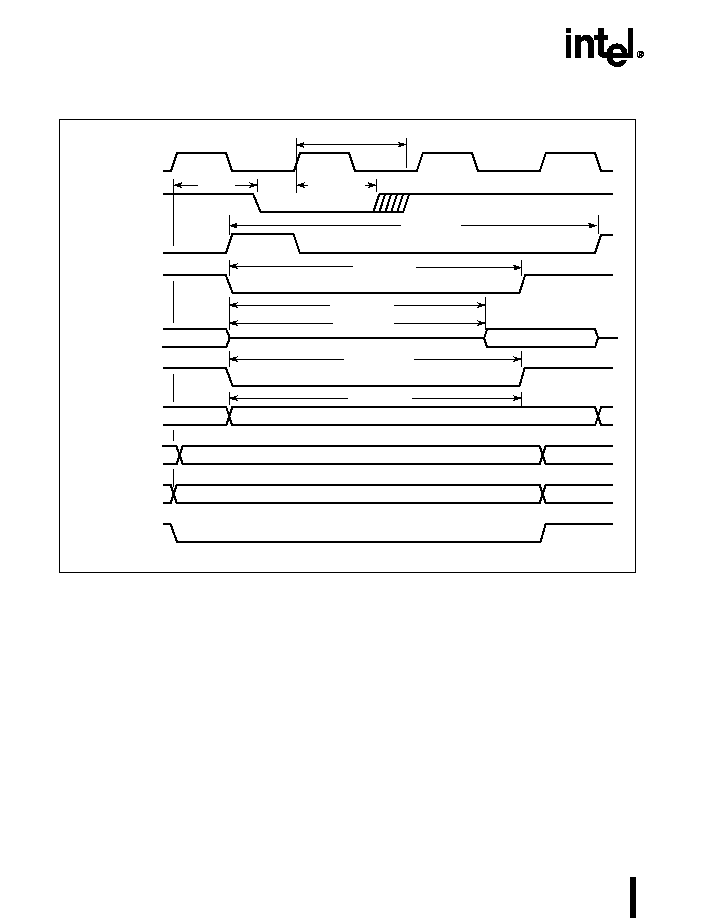
26
ADVANCE INFORMATION
83C196EA CHMOS 16-BIT MICROCONTROLLER -- AUTOMOTIVE
Figure 7. READY Timing Diagram (Demultiplexed Bus Mode)
CLKOUT
READY
ALE
A5398-01
T
CHYX
(min)
T
LHLH
+ 2t
T
AVDV
+ 2t
RD#
AD15:0
(read)
AD15:0
(write)
BHE#, INST
A20:16
CS
x#
T
RLRH
+ 2t
T
AVYV
Data Out
Extended Address Out
T
CHYX
(max)
Data In
T
RLDV
+ 2t
T
WLWH
+ 2t
T
QVWH
+ 2t
WR#
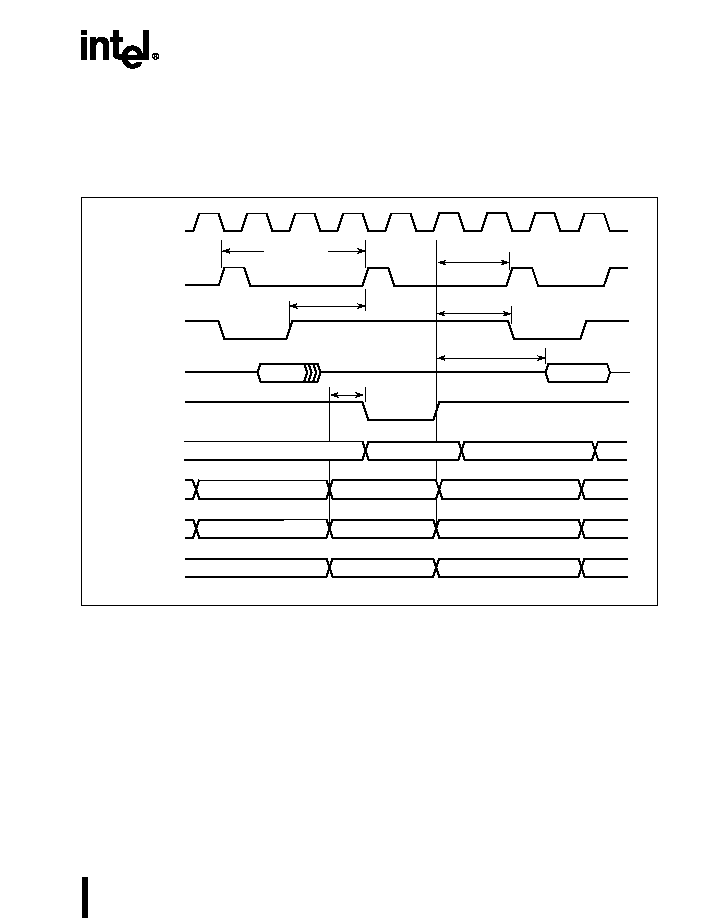
ADVANCE INFORMATION
27
83C196EA CHMOS 16-BIT MICROCONTROLLER -- AUTOMOTIVE
6.4
Deferred Bus Timing Mode
Deferred Bus Cycle Mode: This bus mode (enabled
by setting CCB1.5) reduces bus contention when
using the 83C196EA in demultiplexed mode with
slow memories. As shown in Figure 8, a delay of 2t
occurs in the first bus cycle following a chip-select
output change and the first write cycle following a
read cycle
.
Figure 8. Deferred Bus Mode Timing Diagram
CLKOUT
ALE
RD#
A3246-02
T
WHLH
+ 2t
T
RHLH
+ 2t
T
AVRL
+ 2t
T
AVWL
+ 2t
AD15:0
(read)
WR#
AD15:0
(write)
BHE#, INST
A20:0
CS
x#
T
AVDV
+ 2t
T
LHLH
+ 2t
Data In
Data In
Data Out
Valid
Valid
Data Out
Address Out
Data Out
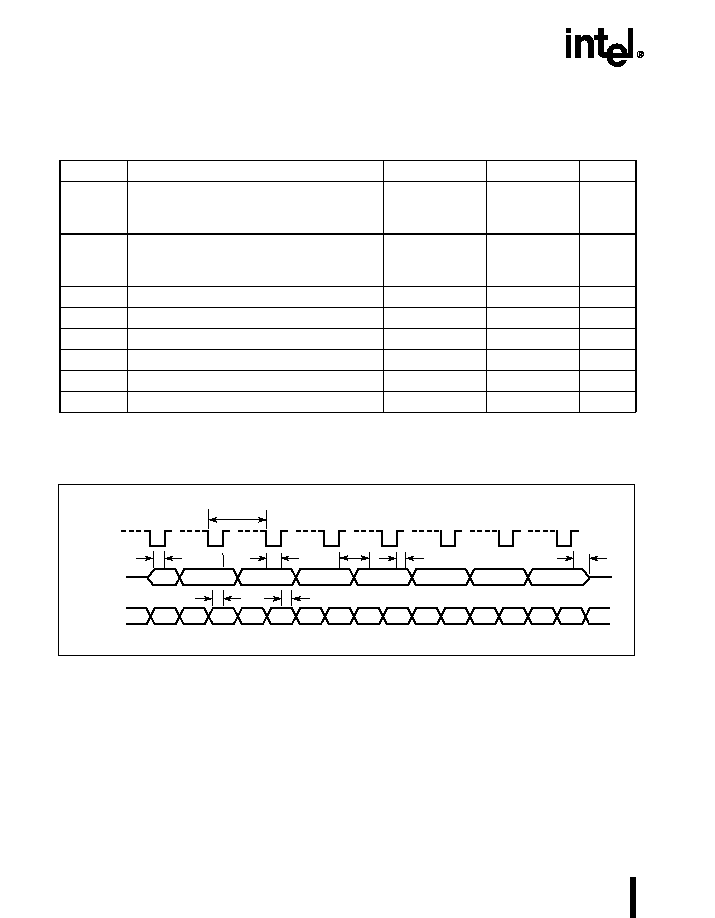
28
ADVANCE INFORMATION
83C196EA CHMOS 16-BIT MICROCONTROLLER -- AUTOMOTIVE
6.5
AC Characteristics -- Serial Port, Shift Register Mode
Figure 9. Serial Port Waveform -- Shift Register Mode
Table 10. Serial Port Timing -- Shift Register Mode
Symbol
Parameter
Min
Max
Units
T
XLXL
Serial Port Clock period
SP_BAUD
x
002H
SP_BAUD
=
x
001H
6t
4t
ns
ns
T
XLXH
Serial Port Clock falling edge to rising edge
SP_BAUD
x
002H
SP_BAUD
=
x
001H
4t ≠ 27
2t ≠ 27
4t + 27
2t + 27
ns
ns
T
QVXH
Output data setup to clock high
4t ≠ 30
ns
T
XHQX
Output data hold after clock high
2t ≠ 30
ns
T
XHQV
Next output data valid after clock high
2t + 30
ns
T
DVXH
Input data setup to clock high
2t + 30
ns
T
XHDX
Input data hold after clock high
0
ns
T
XHQZ
Last clock high to output float
t + 30
ns
The minimum baud-rate (SP_BAUD) register value for receive is
x
002H and the minimum baud-rate
(SP_BAUD) register value for transmit is
x
001H.
A2080-03
Valid
Valid
Valid
Valid
Valid
Valid
Valid
Valid
RXD
x
(In)
TXD
x
0
1
2
3
4
5
6
7
T
QVXH
T
XLXL
T
DVXH
T
XHQV
T
XHQZ
T
XHDX
T
XHQX
T
XLXH
RXD
x
(Out)
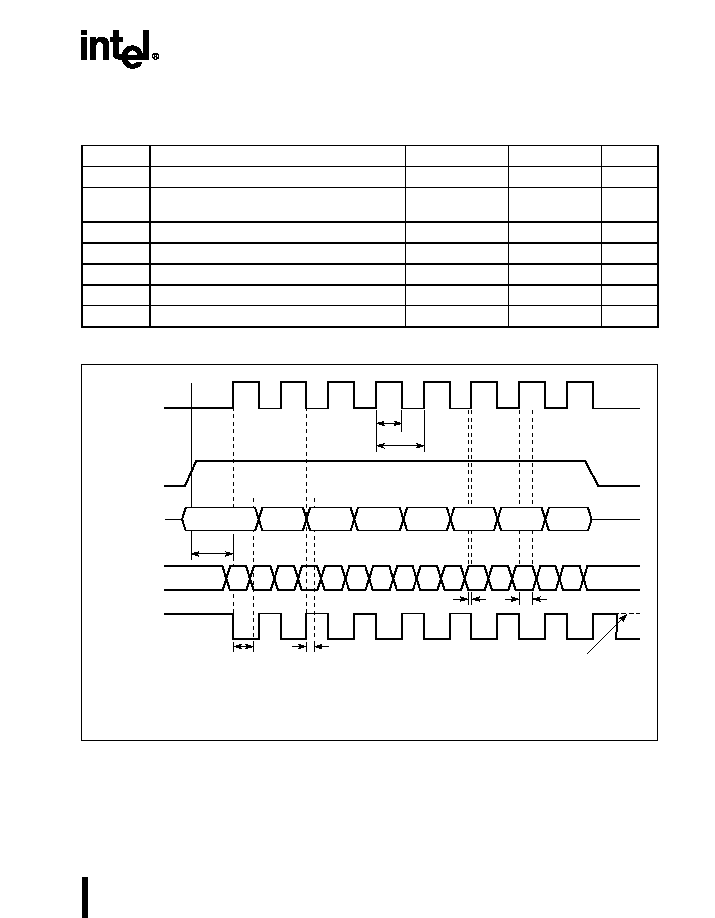
ADVANCE INFORMATION
29
83C196EA CHMOS 16-BIT MICROCONTROLLER -- AUTOMOTIVE
6.6
AC Characteristics -- Synchronous Serial Port
Figure 10. Synchronous Serial Port
Table 11. Synchronous Serial Port Timing
Symbol
Parameter
Min
Max
Units
T
CLCL
Synchronous Serial Port Clock period
8t
ns
T
CLCH
Synchronous Serial Port Clock falling edge to
rising edge
4t
ns
T
D
1
VD
Setup time for MSB output
TBD
ns
T
CXDV
Setup time for D6:0 output
3t + 20
ns
T
CXDX
Output data hold after clock low
t
3t + 20
ns
T
DVCX
Setup time for input data
10
ns
T
DXCX
Input data hold after clock high
t + 5
ns
MSB
D6
D5
D4
D3
D2
D1
D0
valid
valid
valid
valid
valid
valid
valid
valid
1
8
7
6
5
4
3
2
1
8
7
6
5
4
3
2
SC
x
(normal
transfers)
SD
x (out)
SD
x (in)
SC
x
(handshaking
transfers)
Slave Receiver Pulls SC
x low
A3233-02
T
CHCH
T
CHCL
T
CLCH
STE Bit
T
D1DV
T
CXDX
T
CXDV
T
DVCX
T
DXCX
Assumes that the SSIO is configured to sample incoming data on the rising clock edge and sample outgoing
data on the falling clock edge, and that the SSIO is configured to pull the clock signal low while the channel
is idle.

30
ADVANCE INFORMATION
83C196EA CHMOS 16-BIT MICROCONTROLLER -- AUTOMOTIVE
6.7
A/D Sample and Conversion Times
Two parameters, sample time and conversion time, control the time required for an A/D conversion. The
sample time is the length of time that the analog input voltage is actually connected to the sample capacitor.
If this time is too short, the sample capacitor will not charge completely. If the sample time is too long, the
input voltage may change and cause conversion errors. The conversion time is the length of time required to
convert the analog input voltage stored on the sample capacitor to a digital value. The conversion time must
be long enough for the comparator and circuitry to settle and resolve the voltage. Excessively long conversion
times allow the sample capacitor to discharge, degrading accuracy.
The AD_TIME register programs the A/D sample and conversion times. Use the T
SAM
and T
CONV
specifica-
tions in Tables 12 and 14 to determine appropriate values for SAM and CONV; otherwise, erroneous
conversion results may occur.
When the SAM and CONV values are known, write them to the AD_TIME register. Do not write to this register
while a conversion is in progress; the results are unpredictable.
Use the following formulas to determine the SAM and CONV values.
where:
SAM
equals a number, 1 to 7
CONV
equals a number, 2 to 31
T
SAM
is the sample time, in
µ
sec
(Tables 12 and 14)
T
CONV
is the conversion time, in
µ
sec
(Tables 12 and 14)
f
is the operating frequency, in MHz
B
is the number of bits to be converted
(8 or 10)
At 40 Mhz, to meet T
SAM
and T
CONV
minimum specifications:
10-bit mode:
8-bit mode:
SA M
T
S A M
f
2
≠
◊
8
-------------------------------
=
C ONV
T
C O N V
f
◊
3
≠
2
B
◊
----------------------------------
1
≠
=
SAM
5 6 7
, ,
[
]
=
T
SAM
1
µ
s
CONV
18 19 20
...
31
, , , ,
[
]
=
T
CONV
10
µ
s
SAM
5 6 7
, ,
[
]
=
T
SAM
1
µ
s
CONV
23 24
...
31
, , ,
[
]
=
T
CONV
10
µ
s

ADVANCE INFORMATION
31
83C196EA CHMOS 16-BIT MICROCONTROLLER -- AUTOMOTIVE
6.7.1
AC CHARACTERISTICS -- A/D CONVERTER, 10-BIT MODE
Table 12. 10-bit A/D Operating Conditions (1)
Symbol
Description
Min
Max
Units
Notes
T
C
Case Temperature
≠ 40
+ 125
∞
C
V
CC
Digital Supply Voltage
4.50
5.50
V
V
REF
Analog Supply Voltage
4.50
5.50
V
2
T
SAM
Sample Time
1.0
µ
s
3
T
CONV
Conversion Time
10.0
15.0
µ
s
3
NOTES:
1.
ANGND and V
SS
should nominally be at the same potential.
2.
V
REF
must not exceed V
CC
by more than + 0.5 V because V
REF
supplies both the resistor ladder and
the analog portion of the converter and input port pins.
3.
Program the AD_TIME register to meet the T
SAM
and T
CONV
specifications.
Table 13. 10-bit Mode A/D Characteristics Over Specified Operating Conditions (7)
Parameter
Typical (2)
Min
Max
Units (1)
Notes
Resolution
1024
10
1024
10
Levels
Bits
Absolute Error
0
±
3.0
LSBs
Full-scale Error
0.25
±
0.5
LSBs
Zero Offset Error
0.25
±
0.5
LSBs
Nonlinearity
1.0
±
2.0
±
3.0
LSBs
Differential Nonlinearity
≠ 0.75
+ 0.75
LSBs
Channel-to-channel Matching
±
0.1
0
±
1.0
LSBs
Repeatability
±
0.25
0
LSBs
Temperature Coefficients:
Offset
Full-scale
Differential Nonlinearity
0.009
0.009
0.009
LSB/C
LSB/C
LSB/C
Off-isolation
≠ 60
dB
2, 3, 4
NOTES:
1.
An
LSB
, as used here, has a value of approximately 5 mV.
2.
Most parts will need these values at 25
∞
C, but they are not tested or guaranteed.
3.
DC to 100 KHz.
4.
Multiplexer break-before-make guaranteed.
5.
Resistance from device pin, through internal multiplexer, to sample capacitor.
6.
Applying voltage beyond these specifications will degrade the accuracy of other channels being con-
verted.
7.
All conversions were performed with processor in idle mode.
8.
100 mV < V
IN
< V
REF
≠ 100 mV.

32
ADVANCE INFORMATION
83C196EA CHMOS 16-BIT MICROCONTROLLER -- AUTOMOTIVE
6.7.2
AC CHARACTERISTICS -- A/D CONVERTER, 8-BIT MODE
Feedthrough
≠ 60
dB
2, 3
V
CC
Power Supply Rejection
≠ 60
dB
2, 3
Input Series Resistance
750
1.2K
5
Voltage on Analog Input Pin
ANGND
V
REF
V
6
Sampling Capacitor
3.0
pF
DC Input Leakage
±
100
0
±
300
nA
8
Table 14. 8-bit A/D Operating Conditions (1)
Symbol
Description
Min
Max
Units
Note
s
T
C
Case Temperature
≠ 40
+ 125
∞
C
v
CC
Digital Supply Voltage
4.50
5.50
V
v
REF
Analog Supply Voltage
4.50
5.50
V
2
T
SAM
Sample Time
1.0
µ
s
3
T
CONV
Conversion Time
8.0
15.0
µ
s
3
NOTES:
1.
ANGND and V
SS
should nominally be at the same potential.
2.
V
REF
must not exceed V
CC
by more than + 0.5 V because V
REF
supplies both the resistor ladder and
the analog portion of the converter and input port pins.
3.
Program the AD_TIME register to meet the T
SAM
and T
CONV
specifications.
Table 13. 10-bit Mode A/D Characteristics Over Specified Operating Conditions (7) (Continued)
Parameter
Typical (2)
Min
Max
Units (1)
Notes
NOTES:
1.
An
LSB
, as used here, has a value of approximately 5 mV.
2.
Most parts will need these values at 25
∞
C, but they are not tested or guaranteed.
3.
DC to 100 KHz.
4.
Multiplexer break-before-make guaranteed.
5.
Resistance from device pin, through internal multiplexer, to sample capacitor.
6.
Applying voltage beyond these specifications will degrade the accuracy of other channels being con-
verted.
7.
All conversions were performed with processor in idle mode.
8.
100 mV < V
IN
< V
REF
≠ 100 mV.

ADVANCE INFORMATION
33
83C196EA CHMOS 16-BIT MICROCONTROLLER -- AUTOMOTIVE
Table 15. 8-bit Mode A/D Characteristics Over Specified Operating Conditions (7)
Parameter
Typical (2)
Min
Max
Units (1)
Notes
Resolution
256
8
256
8
Levels
Bits
Absolute Error
0
±
1.0
LSBs
Full-scale Error
±
0.5
LSBs
Zero Offset Error
±
0.5
LSBs
Nonlinearity
0
±
1.0
LSBs
Differential Nonlinearity
≠ 0.5
+ 0.5
LSBs
Channel-to-channel Matching
0
±
1.0
LSBs
Repeatability
±
0.25
0
LSBs
Temperature Coefficients:
Offset
Full-scale
Differential Nonlinearity
0.003
0.003
0.003
LSB/
∞
C
LSB/
∞
C
LSB/
∞
C
Off Isolation
≠ 60
dB
2, 3, 4
Feedthrough
≠ 60
dB
2, 3
V
CC
Power Supply Rejection
≠ 60
dB
2, 3
Input Series Resistance
750
1.2K
5
Voltage on Analog Input Pin
ANGND
V
REF
V
6
Sampling Capacitor
3.0
pF
DC Input Leakage
100
0
300
nA
8
NOTES:
1.
An
LSB
, as used here, has a value of approximately 20 mV.
2.
Most parts will need these values at 25
∞
C, but they are not tested or guaranteed.
3.
DC to 100 KHz.
4.
Multiplexer break-before-make guaranteed.
5.
Resistance from device pin, through internal multiplexer, to sample capacitor.
6.
Applying voltage beyond these specifications will degrade the accuracy of other channels being con-
verted.
7.
All conversions were performed with processor in idle mode.
8.
100 mV < V
IN
< V
REF
≠ 100 mV.

34
ADVANCE INFORMATION
83C196EA CHMOS 16-BIT MICROCONTROLLER -- AUTOMOTIVE
6.8
External Clock Drive
Figure 11. External Clock Drive Waveforms
Table 16. External Clock Drive
Symbol
Parameter
Min
Max
Units
1/T
XLXL
Oscillator Frequency (F
XTAL
1
)
8
40 (1)
MHz (2)
T
XLXL
Oscillator Period (T
XTAL
1
)
50
125
ns
T
XHXX
High Time
0.35T
XTAL
1
0.65T
XTAL
1
ns
T
XLXX
Low Time
0.35T
XTAL
1
0.65T
XTAL
1
ns
T
XLXH
Rise Time
10
ns
T
XHXL
Fall Time
10
ns
NOTE:
1.
16 MHz is the maximum input frequency when using an external crystal oscillator; however, 32 MHz
can be applied with an external clock source.
2.
These values represent PLL-bypass mode.
T
XLXX
A2119-03
T
XHXX
T
XHXL
T
XLXL
0.3 V
CC
≠ 0.5 V
0.7 V
CC
+ 0.5 V
T
XLXH
0.7 V
CC
+ 0.5 V
0.3 V
CC
≠ 0.5 V
XTAL1

ADVANCE INFORMATION
35
83C196EA CHMOS 16-BIT MICROCONTROLLER -- AUTOMOTIVE
6.9
Test Output Waveforms
Figure 12. AC Testing Output Waveforms
Figure 13. Float Waveforms During 5.0 Volt Testing
Test Points
2.0 V
0.8 V
Note:
AC testing inputs are driven at 3.5 V for a logic "1" and 0.45 V for a logic
"0". Timing measurements are made at 2.0 V for a logic "1" and 0.8 V for
a logic "0".
3.5 V
0.45 V
A2120-04
2.0 V
0.8 V
V
LOAD
V
LOAD
≠ 0.15 V
V
LOAD
+ 0.15 V
Timing Reference
Points
V
OH
≠ 0.15 V
V
OL
+ 0.15 V
Note:
For timing purposes, a port pin is no longer floating when a 150 mV change from load
voltage occurs and begins to float when a 150 mV change from the loading V
OH
/V
OL
level occurs with I
OL
/I
OH
15 mA.
A2121-03

36
ADVANCE INFORMATION
83C196EA CHMOS 16-BIT MICROCONTROLLER -- AUTOMOTIVE
7.0
THERMAL CHARACTERISTICS
All thermal impedance data is approximate for static
air conditions at 1 watt of power dissipation. Values
will change depending on operating conditions and
the application. The Intel
Packaging Handbook
(order number 240800) describes Intel's thermal
impedance test methodology. The
Components
Quality and Reliability Handbook
(order number
210997) provides quality and reliability information.
8.0
83C196EA ERRATA
The 83C196EA may contain design defects or
errors known as errata. Characterized errata that
may cause the 83C196EA's behavior to deviate
from published specifications are documented in a
specification update. Specification updates can be
obtained from your local Intel sales office or from
the World Wide Web (
www.intel.com
).
9.0
DATASHEET REVISION HISTORY
This datasheet is valid for devices with an "C" at the
end of the topside field process order (FPO)
number. Datasheets are changed as new device
information becomes available. Verify with your
local Intel sales office that you have the latest
version before finalizing a design or ordering
devices.
This is the -002 version of the datasheet. The
following changes were made in this version:
1.
The status of the datasheet was revised from
"Product Preview" to "Advance Information".
2.
The frequency designation was changed from
32 MHz to 40 MHz.
3.
The following DC characteristics specifications
were either changed or added:
∑
I
CC
(max)
∑
I
IDLE
(max)
∑
I
OH
2
∑
I
OH
3
4.
The following AC characteristics multiplexed
bus mode specifications were changed:
∑
T
CHCL
(max)
∑
T
LLCH
(min/max)
∑
T
RLCL
(max)
∑
T
CHWH
(min)
∑
T
WHLH
(max)
∑
T
AVYV
(max)
∑
T
CLYX
(max)
∑
T
WHQX
(min)
∑
T
LLAX
(min)
∑
T
RLDV
(max)
5.
The following AC characteristics demulti-
plexed bus mode specifications were
changed:
∑
T
AVDV
(max)
∑
T
RLDV
(max)
∑
T
SLDV
(max)
∑
T
CHDV
(max)
∑
T
XHCH
min/(max)
∑
T
CHCL
(min/max)
∑
T
CLLH
(min/max)
∑
T
RLCL
(min)
∑
T
RLRH
(min)
∑
T
RHLH
(max)
∑
T
WLCL
(min)
∑
T
QVWH
(min)
∑
T
CHWH
(min)
∑
T
WLWH
(min)
∑
T
WHQX
(max)
∑
T
WHBX
(min)
∑
T
RHBX
(min)
∑
T
AVYV
(max)
∑
T
CLYX
(max)
6.
The following AC characteristics demulti-
plexed bus mode specifications were
removed:
∑
T
LLCH
∑
T
LHLH
∑
T
LHLL
∑
T
WHLH
7.
Address out line in the System Bus Timing
Diagram (Demultiplexed Bus Mode) was cor-
rected from A20:16 to A20:0.
8.
T
CHYX
(max) timing was corrected in the Ready
Timing Diagram to show the rising edge of
READY after the falling edge of CLKOUT.
9.
HOLD#/HLDA# timings section was removed,
and all references to either HOLD# or HLDA#
were removed.
10. Synchronous Serial timing specifications
changed in table.
11. A/D sample and conversion times example
added.
12. Note 1 of the 8-bit mode A/D characteristics
table changed to state 20 mV, instead of 5 mV.
This is the -001 version of the datasheet. The
following changes were made in this version:
1.
Package thermal characteristics changed.
Table 17. Thermal Characteristics
Package Type
JA
JC
160-pin QFP
34
∞
C/W
5
∞
C/W







































